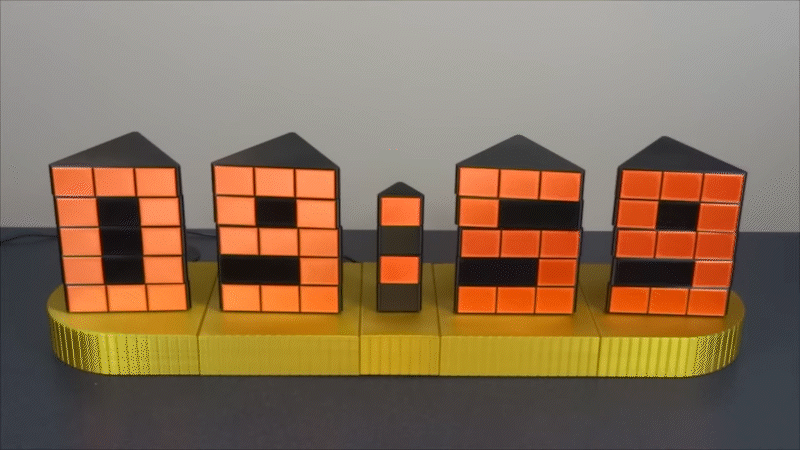[Hans Andersson] has been creating marvelous twisting timepieces for over a decade, and we’re pleased to be able to share his latest mechanical clock contraption with our readers, the Time Twister 5.
In contrast to his previous LEGO-based clocks, version five of the Time Twister uses 3D printed segments, undoubtedly providing greater flexibility in terms of aesthetics and function. Each digit is a mechanical display, five layers vertical and three segments horizontal, with a total of three unique faces. Each layer of each display can be individually rotated by a servo, and this arrangement allows for displaying any number between zero and nine. The whole show is controlled by an Arduino MEGA and a DS3231 real-time clock.
Watching these upended prisms rotate into legible fifteen-segment digits is enjoyable enough already, but the mechanical sound created by this timepiece in motion is arguably even more satisfying. Check out the video below to see (and hear) for yourself. If you want to build one yourself, all the details are here.
We last covered [Hans Andersson] and his very first Time Twister clock way back in November 2011. Since then we’ve come across many impressive mechanical clocks, like this seven-segment work of art. We’re constantly impressed by the outstanding craftsmanship of these mechanical clocks, and it’s inspiring to see one of our OG horologists back in the saddle once more.
















Wow nice! a definite Rubik look :)
That is so cool!
It looks like the 5 layers do not completely rotate, instead move back and forth as needed, so slip ring contacts are not needed.
That’s what puzzled me at first. I noticed that the modules rotate on both directions and then I noticed one module (when changing from 2 to 3) rotated 2 moves and that should never be needed if they can completely rotate as it’s only ever one move (left or right) to the other faces.
Then I saw that it’s servo driven and servo’s can’t (normally) completely rotate.
The motor is in the center, non-rotating part, with planetary gears causing the outer, rotating part to turn.
Now make it silent.
And a bit smaller
No! Make it 5 meters tall and place it in the town square!
B^)
I think it could be made pretty quiet, by making each layer a 6-position stepper motor, and using microstepping or just low drive power to go from one state to the next. This could also make each transition doable with only a single step, since as [RÖB] points out, with only three positions, each position is only one move away from any other position.
Another option would be to use a two-phase motor, similar to what is used on some analog automotive gauges, where there is a magnet on a shaft, with two coils mounted 90 degrees from each other, and you just drive these proportionately to the sine and cosine of the angle you want, to go directly to any position. Very quiet, and can also be scaled down much easier than servos can be. They also have an advantage over steppers, in that you don’t need to know the current position in order to drive them to a new position. The disadvantage is that you have to drive them with either an analog voltage or current, or a PWM signal. Note that what I’m referring to are the older analog gauge motors found in (for example) my ’97 Explorer that have three terminals, “S”, “B”, and “G” (sensor, battery, ground??), not the newer gauges that use 4-terminal low-power stepper motors. Although those should also work, only differently.
and less complex.there should be a mechanical way with cam (no, electromechanical devices not dead) to make each digit work with 1 stepper.
Like going backwards for selecting row, going forward to rotate row.
Oh man that looks so cool. Glad I don’t have one, I’d spend all day staring at the clock.
If you’d like to have a sense of impending doom and inescapable mortality when looking at a clock, buy one with a “sweep” (smooth, continuous, no sound ideally) second hand. Just terrifying how quickly that slides around
this looks and works awesome, very cool!
Incredibly creative and cool!
thats crazy cool, when you think you seen it all :)
Every time I see a new way to make a clock I think ‘I wish I’d thought of that’.
Well, as usual, I wish I’d thought of that. Genius!
This….in a watch!
This is beyond cool!
I would try electromagnets to make it more accurate in posizioning the blocks and silent.